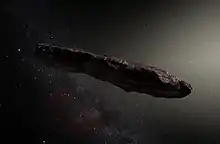 | |
| Discovery[3][4] | |
|---|---|
| Discovery site | Korea Astronomy and Space Science Institute and Spitzer Space Telescope[4] |
| Discovery date | 2017 |
| Gravitational microlensing[4] | |
| Orbital characteristics | |
| 2.62±0.28 | |
| Star | OGLE-2016-BLG-1195L |
| Physical characteristics | |
| Mass | 9.91±1.61[6] MEarth |
OGLE-2016-BLG-1195Lb is an extrasolar planet located about 22,000 light-years from Earth, in the galactic bulge, orbiting the 0.57±0.06M☉[6] star OGLE-2016-BLG-1195L, discovered in 2017.[4][5][3] The planet was detected using gravitational microlensing techniques managed by the Korea Astronomy and Space Science Institute and the Spitzer Space Telescope. Initially, it was believed the planet has a mass similar to Earth and is located about the same distance from its host star as the Earth is from the Sun,[4] although it was expected to be much colder.[7][8][4]
In 2023, the planetary mass estimate was significantly increased to 9.91±1.61MEarth, resulting in it likely being a Neptune-like ice giant planet.[6]
In popular culture
The planet has been referred to as Hoth due to its resemblance (before 2023 parameters update) to the planet with the same name from the Star Wars franchise.[8] A similar exoplanet, OGLE-2005-BLG-390Lb, has also been compared to Hoth, by NASA in this instance.[9]
See also
References
- ↑ Shvartzvald, Y; et al. (1 May 2017). "An Earth-mass Planet in a 1 au Orbit around an Ultracool Dwarf". The Astrophysical Journal Letters. 840 (L3): L3. arXiv:1703.08548. Bibcode:2017ApJ...840L...3S. doi:10.3847/2041-8213/aa6d09. hdl:10092/13689.
- ↑ Bond, I. A.; et al. (25 March 2017). "The Lowest Mass Ratio Planetary Microlens: OGLE 2016-BLG-1195Lb". Monthly Notices of the Royal Astronomical Society. 469 (2): 2434–2440. arXiv:1703.08639. Bibcode:2017MNRAS.469.2434B. doi:10.1093/mnras/stx1049.
- 1 2 3 Staff (2017). "Planet OGLE-BLG-1195L b". Extrasolar Planets Encyclopaedia. Archived from the original on 31 March 2017. Retrieved 27 April 2017.
- 1 2 3 4 5 6 7 Staff (26 April 2017). "PIA21430: Iceball Planet Artist's Concept". NASA. Retrieved 27 April 2017.
- 1 2 Landau, Elizabeth (26 April 2017). "'Iceball' Planet Discovered Through Microlensing". NASA. Retrieved 27 April 2017.
- 1 2 3 Vandorou, Aikaterini; Dang, Lisa; Bennett, David P.; Koshimoto, Naoki; Terry, Sean K.; Beaulieu, Jean-Phillipe; Alard, Christophe; Bhattacharya, Aparna; Blackman, Joshua W.; Bouchoutrouch-Ku, Tarik; Cole, Andrew A.; Cowan, Nicolas B.; Marquette, Jean-Baptiste; Ranc, Clément; Rektsini, Natalia (2023), OGLE-2016-BLG-1195Lb: A SUB-NEPTUNE BEYOND THE SNOW LINE OF AN M-DWARF CONFIRMED BY KECK AO, arXiv:2302.01168
- ↑ "'Iceball' planet discovered through microlensing".
- 1 2 Strickland, Ashley (26 April 2017). "Icy Earth-mass exoplanet is 'colder than Hoth'". CNN. Retrieved 27 April 2017.
- ↑ Brennan, Pat (15 December 2015). "8 planets that make you think Star Wars is real". NASA. Retrieved 29 April 2017.



